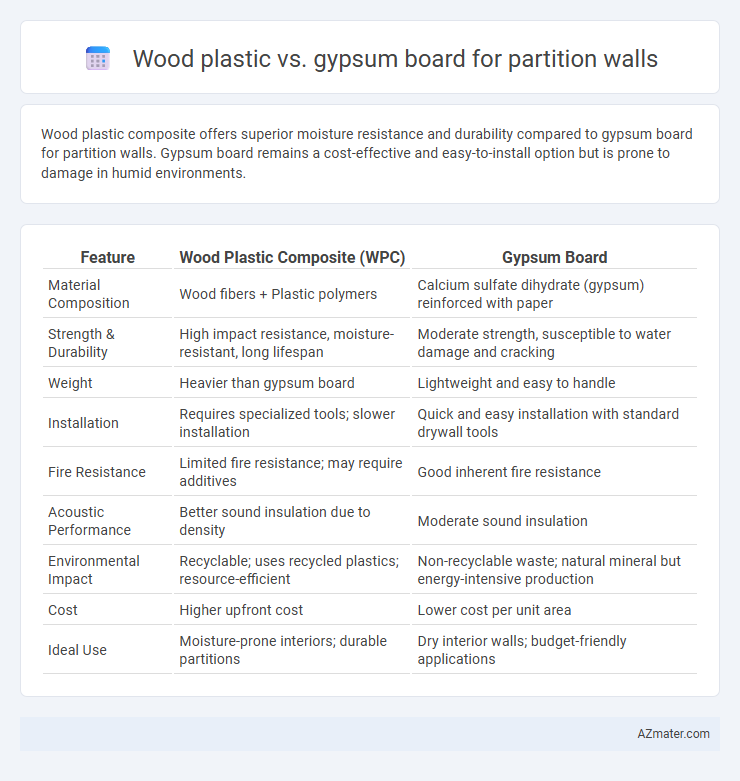Wood plastic composite offers superior moisture resistance and durability compared to gypsum board for partition walls. Gypsum board remains a cost-effective and easy-to-install option but is prone to damage in humid environments.
Table of Comparison
| Feature | Wood Plastic Composite (WPC) | Gypsum Board |
|---|---|---|
| Material Composition | Wood fibers + Plastic polymers | Calcium sulfate dihydrate (gypsum) reinforced with paper |
| Strength & Durability | High impact resistance, moisture-resistant, long lifespan | Moderate strength, susceptible to water damage and cracking |
| Weight | Heavier than gypsum board | Lightweight and easy to handle |
| Installation | Requires specialized tools; slower installation | Quick and easy installation with standard drywall tools |
| Fire Resistance | Limited fire resistance; may require additives | Good inherent fire resistance |
| Acoustic Performance | Better sound insulation due to density | Moderate sound insulation |
| Environmental Impact | Recyclable; uses recycled plastics; resource-efficient | Non-recyclable waste; natural mineral but energy-intensive production |
| Cost | Higher upfront cost | Lower cost per unit area |
| Ideal Use | Moisture-prone interiors; durable partitions | Dry interior walls; budget-friendly applications |
Introduction to Partition Wall Materials
Wood plastic composites offer durability, moisture resistance, and eco-friendly properties for partition walls, making them suitable for areas prone to humidity. Gypsum board remains a popular choice due to its fire resistance, ease of installation, and smooth finish, ideal for interior partitions. Choosing between wood plastic and gypsum board depends on factors like environmental conditions, structural requirements, and aesthetic preferences.
Overview of Wood Plastic Composite (WPC)
Wood Plastic Composite (WPC) is a durable, lightweight material made from a blend of wood fibers and thermoplastic polymers, offering superior moisture resistance and low maintenance compared to traditional gypsum board. Its enhanced durability and resistance to mold and rot make WPC ideal for partition walls in humid or high-traffic environments. WPC's eco-friendly properties and ability to be recycled further contribute to its growing popularity as a sustainable alternative in interior partition applications.
Understanding Gypsum Board
Gypsum board, composed of calcium sulfate dihydrate, is a popular material for partition walls due to its fire resistance, sound insulation, and smooth finish, making it ideal for both residential and commercial construction. Unlike wood plastic composites, gypsum board is lightweight, easy to install, and provides better resistance to moisture and mold when properly treated, enhancing indoor air quality. Its cost-effectiveness and ability to be painted or wallpapered contribute to its widespread use in creating functional and aesthetically pleasing interior partitions.
Installation Process: WPC vs Gypsum Board
Wood plastic composite (WPC) panels offer a straightforward installation process with lightweight, interlocking designs that reduce the need for additional support structures compared to traditional gypsum board. Gypsum board installation typically involves cutting, framing, fastening with screws, taping, and joint compound application, which requires skilled labor and longer drying times. WPC's moisture-resistant properties also minimize installation delays caused by humidity, making it a faster and more durable option for partition walls.
Durability and Lifespan Comparison
Wood plastic composite (WPC) offers superior durability compared to gypsum board, as it resists moisture, mold, and insect damage, making it ideal for high-humidity areas. Gypsum board, while cost-effective and easy to install, is prone to water damage and sagging over time, significantly reducing its lifespan in damp environments. WPC partitions typically last 15-25 years with minimal maintenance, whereas gypsum board partitions may require replacement or repairs within 10-15 years under similar conditions.
Moisture and Fire Resistance
Wood plastic composites exhibit superior moisture resistance compared to gypsum board, making them ideal for humid environments where water exposure is frequent. Gypsum board, despite its inherent fire-resistant properties due to calcium sulfate dihydrate, can degrade when exposed to prolonged moisture, compromising its structural integrity. Wood plastic materials combine fire retardant additives that enhance flame resistance while maintaining durability under wet conditions, offering a balanced solution for partition walls requiring both moisture and fire resistance.
Sound Insulation and Thermal Properties
Wood plastic composites offer superior sound insulation due to their density and ability to absorb vibrations, making them effective for partition walls in noisy environments. Gypsum board, while easier to install and more cost-effective, provides moderate soundproofing but excels in thermal properties by offering better fire resistance and temperature regulation. Choosing between wood plastic and gypsum board depends on prioritizing acoustic performance or thermal efficiency in partition wall construction.
Environmental Impact and Sustainability
Wood plastic composites (WPC) offer enhanced sustainability through the utilization of recycled plastics and wood fibers, reducing landfill waste and lowering the demand for virgin materials compared to gypsum boards. Gypsum board, while commonly used for partition walls, relies on mined gypsum which involves resource-intensive processes and generates waste; however, it is fully recyclable and has low embodied energy when sourced properly. WPC partitions exhibit greater durability and resistance to moisture, extending their lifespan and reducing replacement frequency, whereas gypsum boards may require more frequent maintenance and disposal, impacting long-term environmental performance.
Cost Analysis: Initial and Long-term
Wood plastic composite (WPC) partitions generally have a higher initial cost compared to gypsum board due to raw material expenses and manufacturing complexity. Over the long term, WPC offers better durability, moisture resistance, and lower maintenance costs, reducing overall expenditure despite the upfront investment. Gypsum board partitions are cheaper initially but may incur higher repair and replacement costs due to susceptibility to moisture damage and lower impact resistance.
Best Applications for WPC and Gypsum Board
Wood Plastic Composite (WPC) is ideal for partition walls in high-moisture areas such as bathrooms and kitchens due to its water resistance, durability, and termite-proof properties. Gypsum Board excels in interior applications requiring smooth finishes and fire resistance, making it suitable for office partitions and residential room dividers. When sound insulation and quick installation are priorities, Gypsum Board is preferred, whereas WPC suits environments demanding longevity and minimal maintenance.

Infographic: Wood plastic vs Gypsum board for Partition wall
 azmater.com
azmater.com